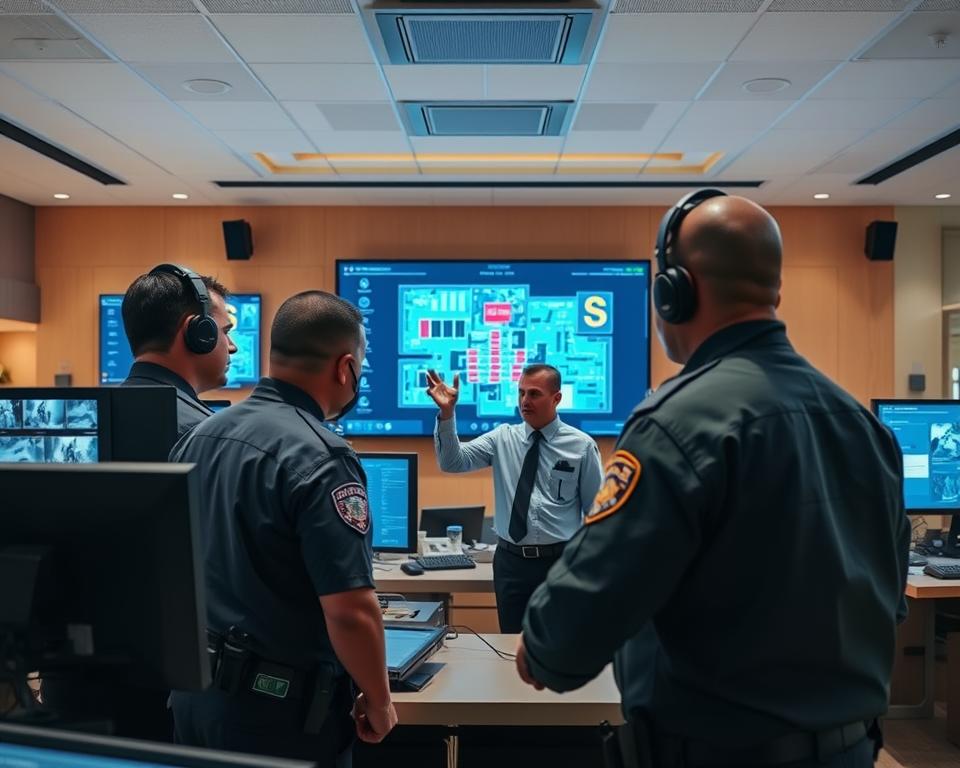Improving Your Safety using Mall Security Measures
Imagine if the secret to safer shopping isn’t only cameras and guards? With growing crowds and evolving risks, safe areas call for more than classic methods. Current security issues need clever approaches merging human skill and modern technology.
Amid growing worries over public safety, companies now emphasize strong protection systems. Divine Protection Services spearheads this change, blending thorough training and state-of-the-art tools to create industry criteria. Their method emphasizes proactive apartment building security actions instead of reactive responses.
Properly trained officers are crucial for keeping order. They oversee crowded spots, handle emergencies, and foster trust by being visible. This people-first philosophy makes sure shoppers and staff feel safe on each visit.
Upcoming sections will explore how surveillance innovations and access controls create seamless security networks. Learn how strategic planning turns malls into safe havens while driving business growth.
Recognizing Why Mall Security Matters
Creating safe spaces for shoppers and employees starts with more than visible patrols. Modern protection programs rely on layered approaches that combine technology, training, and teamwork. These methods accomplish more than simply reacting to problems—they forestall them.

Surveillance and Access Control: Their Role
High-definition cameras and smart entry systems form the backbone of modern safety plans. Sensors placed strategically monitor busy areas like entrances and parking lots. This arrangement lets staff detect odd behavior swiftly.
Entry control tools confine access to designated areas while enabling customers to walk freely through stores. Periodic device checks ensure cameras and scanners run smoothly. Real-time monitoring enables teams to intervene before small issues intensify.
Safety, Brand Image, and Client Experience
Well-trained officers do more than watch screens—they assist lost visitors and de-escalate conflicts. Their presence reassures patrons, encouraging longer stays and repeat visits. A single incident can damage trust, making prevention critical.
Funding continuous staff training ensures teams manage medical emergencies or crowd surges well. When protective actions mesh with daily workflows, firms flourish in safer environments.
Divine Protection Services: Your Partner in Mall Safety
When safety becomes a priority, businesses need partners who deliver more than promises. Divine Protection Services prevails by merging advanced tools with qualified personnel to confront current risks. Their tactics evolve with new challenges while keeping a hospitable atmosphere for visitors.
Our Complete Security Strategy
This agency integrates three pillars for utmost effectiveness:
- Advanced surveillance networks overseeing crowded zones
- Access control systems that regulate entry without impeding foot traffic
- Frequent equipment upgrades ensuring consistent performance
Their teams use real-time data to identify unusual patterns, from unattended bags to unauthorized entries. This proactive method prevents issues before they escalate, keeping public spaces secure yet accessible.
Strengthening Security Officers with Training and Support
Divine Protection Services dedicates substantial resources to skill development. Officers receive:
- BST certification for addressing aggressive behavior
- First aid preparation for medical crises
- Customer service workshops enhancing visitor interactions
Ongoing development opportunities guarantee teams are equipped for different scenarios. “Our team members aren’t just guards—they’re safety ambassadors,” mentions a company spokeswoman. This attention to growth instills confidence in both personnel and customers, establishing environments where everyone flourishes.
Training, Certifications, and Personnel Excellence in Security
Enabling security team members requires more than just a uniform—it demands thorough preparation. Teams excel when armed with certifications and practical exercises designed for modern challenges. This groundwork transforms daily interactions into chances to foster trust and avert incidents.
Core Training Programs and Certifications
Officers begin with three core certifications: BST for conflict resolution, first aid for medical crises, and non-violent intervention tactics. These abilities aid in defusing tense scenarios while putting visitor safety first. Frequent sessions update these skills, ensuring teams adapt to evolving threats.
Simulation training recreates real-world situations like crowd surges or separated children. On-demand courses cover emerging trends, from digital monitoring tools to accessibility protocols. “Training never ceases—it grows,” explains a Divine Protection Services instructor. This method keeps teams prepared for both standard duties and sudden alarms.
Fostering a People-First Culture in Security
Ongoing education nurtures empathy and problem-solving skills essential for public areas. Personnel instructed in customer service help shoppers with directions or store tips, mixing safety with hospitality. This combined focus builds inviting environments where people feel appreciated.
Divine Protection Services bolsters this culture via mentorship schemes and equipment mastery workshops. Confident, well-equipped teams diminish risks while enhancing community bonds. The result? Safer shopping areas where employees and visitors alike can focus on what matters most.
Mall Security: Recommendations for a Safe Shopping Environment
How do popular shopping centers integrate safety with efficient visitor experiences? The solution is melding vigilant technology with friendly personnel. Modern strategies focus on preventing issues while maintaining welcoming atmospheres.
Boosting Visibility via Technology
High-resolution cameras now cover key zones like parking garages and food courts. These networks utilize motion detection to spot unusual behavior, such as abandoned packages or erratic movements. Consolidated dashboards enable teams to monitor multiple areas simultaneously.
Periodic upkeep tests confirm sensors and alarms work without issues. “Our weekly system checks stop 90% of likely malfunctions,” notes a retail safety manager. Combining live streams with AI analysis helps detect patterns human eyes could miss.
Integrating Safety With Hospitality
Experienced officers often act as information guides. They guide shoppers with store directions, lost items, and parking queries. This dual function cultivates trust while ensuring security.
Access control devices like smart turnstiles block entry to staff-only zones without hindering foot traffic. Color-coded IDs enable instant identification of authorized personnel. At busy times, temporary checkpoints control crowd movement near busy stores.
Monthly group meetings between teams confirm everyone is aware of emergency protocols. Simple upgrades—like brighter lighting near restrooms—can deter incidents while improving visitor comfort. When tech and teamwork synchronize, public spaces become safer and more pleasant.
Dealing with Emergencies and Crowds in Shopping Malls
When seconds count, how do crowded spaces transform chaos into order? Successful emergency strategies fuse clear protocols with rehearsed teamwork. Preparation turns potential disasters into manageable situations where everyone knows their role.
Responsive Emergency Management Techniques
Preplanned action plans are crucial in emergencies. Crews use color-coded signals to mark different threat levels—red for fires, yellow for medical issues. This setup helps staff respond quickly without confusion.
Primary strategies encompass:
- Assigned evacuation pathways marked with glow-in-the-dark signs
- Real-time communication via encrypted earpieces
- Automated lockdown features for restricted areas
Security officers schooled in crowd psychology guide visitors with tranquil verbal hints and visual signals. “We practice疏散 drills monthly to keep reactions instinctive,” shares a retail safety coordinator. Camera feeds help recognize bottlenecks, enabling teams to reroute traffic before panic spreads.
Local fire services get real-time updates via integrated systems during incidents. Collaborative training drills guarantee smooth collaboration. Post-incident reviews identify areas for improvement, such as quicker first aid deployment.
A Midwest complex decreased evacuation times by 40% after updating their speaker system. Regular updates to response protocols ensure teams adapt to new challenges while maintaining visitor confidence.
Technological Progress and Future Directions in Mall Security
Picture walking into an environment where safety systems predict dangers before they arise. State-of-the-art advancements are transforming how public spaces secure visitors while boosting convenience. From AI-driven analytics to biometric scanners, tomorrow’s solutions blend precision with seamless operations.
Smart Systems for Proactive Protection
Machine learning now analyzes camera feeds to detect unusual behavior, like unattended bags or erratic movements. These tools alert on potential hazards faster than manual monitoring. Predictive systems analyze historical data to estimate peak traffic intervals, aiding teams in allocating resources effectively.
Advanced access systems use facial recognition to grant entry to restricted zones. “Biometric tech reduces unauthorized access by 78%,” notes a retail safety expert. Instant dashboards present crowd density analytics, enabling officers to redirect foot traffic before bottlenecks emerge.
Training sessions now feature virtual reality simulations. Guards rehearse dealing with situations from medical emergencies to active threats. This hands-on approach builds muscle memory for high-pressure situations.
Future trends point to drone patrols for parking lots and IoT-connected sensors detecting environmental hazards. As technology advances, shoppers experience smoother visits while feeling secure. Companies using these tools remain ahead in crafting spaces where security and satisfaction flourish together.
In Conclusion: Enhancing Mall Safety with Confidence
Creating safer mall environments begins with trust in both planning and execution. Divine Protection Services drives this initiative by blending AI-based tools with thoroughly trained personnel. Their approach transforms standard protocols into dynamic systems that adapt to evolving challenges.
Today’s safety depends on three pillars: real-time monitoring, precise access control, and prompt emergency response. Squads leveraging predictive analytics can detect risks before they intensify, while customer-centric officers ensure seamless operations. This fusion of tech and human touch forms venues where guests feel protected yet free to roam.
Committing to ongoing improvements guarantees long-term success. From biometric devices to crowd control algorithms, innovation keeps facilities ahead of threats. Working with authorities like Divine Protection Services ensures bespoke solutions that develop with your needs.
Prepared to improve your safety standards? Discover how advanced systems and caring service can transform your environment. Peace of mind begins with proactive partnerships—start the journey to a safer future now.
Top Questions
How does access control enhance safety in public areas?
Access control limits entry points, reduces unauthorized access, and helps teams monitor foot traffic. Tools such as keycard readers or biometric scanners guarantee only authorized visitors enter restricted areas, providing a safer environment for all.
What certifications must security officers have?
Security personnel should obtain certifications like CPR/First Aid, crisis intervention training (CIT), and state-authorized licensing. Programs such as ASP baton training or de-escalation classes also train teams to handle high-pressure situations effectively.
How do surveillance systems manage large crowds?
Modern systems use AI-powered cameras to track movement patterns and detect anomalies. In busy times, live feeds assist teams in rerouting foot traffic, handling bottlenecks, and reacting rapidly to incidents without disturbing shoppers.
Why is customer service important for security personnel?
Courteous interactions cultivate trust and prompt patrons to report concerns. Officers trained in communication skills can assist with directions, lost items, or minor conflicts, enhancing the overall experience while maintaining vigilance.
What function does technology serve in emergency response?
Devices like panic buttons, live communication apps, and unified alarm systems enable teams to coordinate more rapidly. For example, automated alerts can lock down sections or guide evacuations during critical situations.
How does Divine Protection Services back its teams?
They provide ongoing training, advanced equipment like body cameras, and 24/7 operational backup. Regular drills and access to industry experts ensure officers stay prepared for evolving challenges in public spaces.
Can AI minimize risks in retail environments?
Absolutely! ML examines data to forecast theft or accident hotspots. Cameras using facial recognition or plate scanning likewise help spot repeat offenders before problems intensify.
What strategies prevent conflicts during busy seasons?
Prominent signage, designated rest zones, and staggered entry points reduce congestion. Officers trained in crowd management use non-confrontational techniques to de-escalate tensions and keep gatherings orderly.

